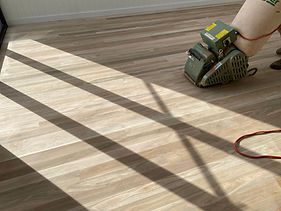
When it comes to timber finishes, the options may seem overwhelming. However, they can generally be divided into three main categories: surface finish, composite finish, and flexible/penetrating finish. Understanding the characteristics of each will help you make an informed choice for your timber flooring project.
1. Surface Finish:
Surface finishes act as a protective shield that adheres to the surface of your timber, forming a thin, clear plastic film. Here are the pros and cons:
Pros:
Surface finishes, such as solvent-based or water-based polyurethane, are widely used and readily available in Victoria.
They are easy to clean and maintain, making them a popular choice for many homeowners.
Surface finishes offer exceptional durability and water resistance.
Various sheen options, such as satin, gloss, and matte, allow you to customize the desired aesthetic.
They can be combined with different colors, providing versatility in design.
Cons:
Deep scratches and dents can be challenging to repair.
Some surface finishes have a higher VOC content, although water-based options have lower VOC ratings.
Cracks may appear when the timber undergoes movement or shifting.

2. Composite Finish
Composite finishes combine the benefits of a surface finish with elements of a penetrating finish, offering versatility and durability. Consider the following:
Pros:
Composite finishes, which blend oil and polyurethane, provide a balanced option.
They allow for slight movement within the timber without severe cracking.
Spot touch-ups with wax are possible for minor scratches and dents.
Multiple finishes, such as satin or matte, are available.
Cons:
The color of the timber may darken and yellow over time.
Areas with high traffic may require additional maintenance and care.
They are not as hard or durable as top/surface finishes.

3. Flexible Finish – Penetrating Finish
Penetrating finishes, such as oils and waxes, penetrate the timber to provide water resistance and a matte finish. Explore their pros and cons:
Pros:
Most penetrating finishes are non-toxic and hypoallergenic, making them a safe choice for households.
There are no edge bonding or cracking issues associated with surface finishes.
Minor scratches and dents can be easily fixed with additional oil or wax and buffing.
Maintenance is generally possible and can be done with a buffer machine.
The matte and soft-to-touch surface allows the natural timber grain to shine.
Cons:
Penetrating finishes offer only a matte sheen option, lacking the variety found in surface finishes.
Without a protective surface layer, damage and scratches are more visible under heavy traffic.
Deep scratches can darken over time if left without proper care.
They can be a more expensive option compared to other surface or composite finishes.

Now that you have a general overview of the different timber finishes and their pros and cons, you can make a confident decision for your upcoming project. If you have any further questions or need personalized assistance, feel free to reach out to us at Info@myflooring.com.au or fill out our online quote request. Good luck with your timber flooring journey!
If you have any questions or need a little extra advice, feel free to reach out to us at info@myflooring.com.au, or simply fill out the online quote form below.
We’re always happy to help wherever we can.
Wishing you all the best with your project!

